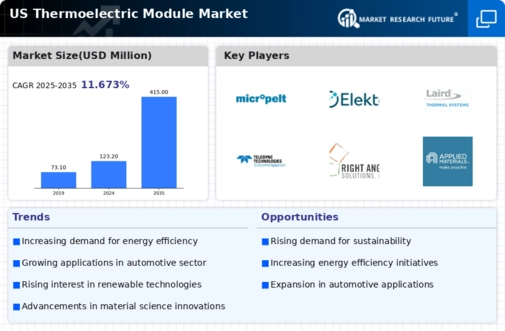Growing Focus on Renewable Energy Sources
The increasing emphasis on renewable energy sources in the US is driving the thermoelectric module market. As the nation seeks to reduce its carbon footprint, thermoelectric modules are being recognized for their potential to convert waste heat into usable energy. This aligns with the broader energy transition goals, where the US government aims for a 50% reduction in greenhouse gas emissions by 2030. the thermoelectric module market is likely to benefit from this shift, as industries seek innovative solutions to harness energy more efficiently.. Furthermore, the integration of thermoelectric technology in renewable energy systems, such as solar and geothermal, could enhance overall energy efficiency, thereby expanding market opportunities. The growing focus on sustainability is expected to propel investments in the thermoelectric module market, fostering advancements in technology and applications.
Government Incentives for Clean Technology
government incentives aimed at promoting clean technology are playing a pivotal role in shaping this market.. Various federal and state programs are designed to encourage the adoption of energy-efficient technologies, including thermoelectric modules. These incentives may include tax credits, grants, and subsidies for companies investing in clean energy solutions. As the US government continues to prioritize sustainability, the thermoelectric module market is likely to benefit from increased funding and support for research and development. This supportive environment could lead to accelerated innovation and commercialization of thermoelectric technologies, ultimately enhancing their market presence. The potential for financial assistance may also encourage more industries to explore the integration of thermoelectric modules into their operations.
Increasing Applications in Automotive Sector
the automotive sector's growing interest in thermoelectric modules is emerging as a key driver for this market.. With the rise of electric vehicles (EVs) and the need for efficient thermal management systems, thermoelectric modules are being integrated into vehicle designs to recover waste heat from engines and improve overall energy efficiency. This trend is particularly relevant as the US aims to have 50% of new vehicle sales be electric by 2030. The thermoelectric module market is likely to see substantial growth as automotive manufacturers seek to enhance vehicle performance and reduce emissions. Additionally, the potential for thermoelectric modules to power auxiliary systems in vehicles could further expand their applications, making them an attractive option for the automotive industry.
Rising Demand for Miniaturization in Electronics
the trend towards miniaturization in the electronics industry is influencing this market.. As devices become smaller and more compact, the need for efficient thermal management solutions is becoming increasingly critical. Thermoelectric modules offer a unique advantage by providing cooling and heating capabilities in a compact form factor. This is particularly relevant in applications such as portable electronics, where space is limited. The thermoelectric module market is expected to grow as manufacturers seek to incorporate these modules into their designs to enhance performance and reliability. Furthermore, the increasing demand for wearable technology and IoT devices is likely to drive innovation in thermoelectric solutions, creating new opportunities for market expansion.
Technological Innovations in Thermoelectric Materials
Technological advancements in thermoelectric materials are significantly impacting the thermoelectric module market. Research institutions and companies are actively developing new materials that exhibit improved thermoelectric performance, such as higher Seebeck coefficients and lower thermal conductivity. For instance, the introduction of nanostructured materials has shown promise in enhancing the efficiency of thermoelectric modules. The market is projected to grow as these innovations lead to more efficient and cost-effective solutions for energy conversion. In 2025, the thermoelectric module market will reach a valuation of approximately $1.5 billion, driven by these advancements.. As the demand for high-performance thermoelectric modules increases, manufacturers are likely to invest in R&D to stay competitive, further propelling the market forward.
















Leave a Comment